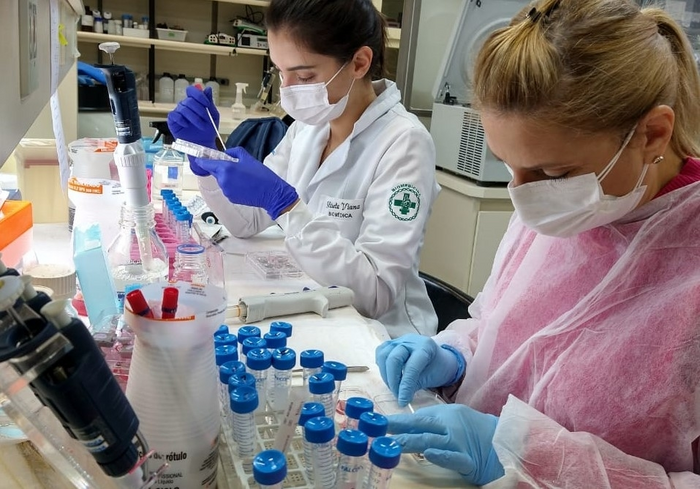Bioprinting Skin for Cosmetics and Drug Testing
Bioprinting skin models that react on par with actual skin could lead to new possibilities for how labs test cosmetics and drugs.
By Naushin Raheema
Animals employed in cosmetics testing often experience a variety of unpleasant treatments in laboratories. According to Stefane Kabene and Said Baadel’s study on bioethics, cosmetics are often tested on animals by repeatedly applying chemicals to the animals’ skin or having them ingest the substances. The goal of this experiment is to see what happens to the animals when they are exposed to certain substances for a long time.
Once a lab’s testing with an animal has concluded, the animal’s life is often terminated because it serves no further use to the lab. Guinea pigs, mice, rats, and rabbits are the most popular test subjects. Nonetheless, cats and dogs are occasionally utilized as well. Kabene and Baadel also explain that the availability of alternative ways of testing cosmetics makes justifying animal testing difficult. To provide even better alternatives to animal testing, scientists have been working on a new type of technology to change how products are tested before hitting the shelves.
The artificial skin
The use of bioengineered synthetic skin to assess the safety and efficacy of pharmaceuticals and cosmetics is rapidly growing in importance and credibility. It can be made on a large scale and is a good alternative to using animals in scientific research. Three-dimensional (3D) bioprinting is one of the most promising technologies for creating in vitro models right now, meaning models in a culture dish or test tube. This was the primary motivation for a recent study by scientists at Brazil’s University of São Paulo’s School of Pharmaceutical Sciences.
Tissue engineering has made it possible to create in vitro human mimetic tissues, or artificial skin, that is more comparable to human tissues in order to test the quality and safety of consumer items without using animals, making this practice both more accurate and more ethical. To figure out how likely it is that topical treatments or chemicals will cause irritation, researchers need a solid foundation. The reconstruction of human skin models provides this.
However, these models require continual updating. So, modern bioprinting technology is promising because it can be automated, scaled up, and use biomaterials that are pre-deposited in specific places to make skin models that both look more real and can be made over and over again. Although there has been progress in the creation of tissue replacements, a long way still has to be traveled before these substitutes can provide a solution to the most pressing biomedical issues of the present day.
Insights on bioprinting reconstructed human epidermis
Researchers in this newest study concluded that highly uniform skin mimetic models is an increasingly important goal of bioprinting technology to be able to accomplish wider-scale regulatory testing of products. In the coming decade, the skin model industry and regulatory approval of open-source models are expected to undergo substantial shifts, according to researchers Helena Kandorava and Patrick J. Hayden, writing in 2020. Based on previous work on manually reconstructing the human epidermis, this most recent research study devised a bioprinting procedure.
The research used two models: bioprinted reconstructed human epidermis and manually reconstructed human epidermis. Validation criteria for this particular study were set by international organizations such as the Organisation for Economic Co-operation and Development (OECD) for quality control and performance assessment. To begin, the epidermis was stratified into four layers (the strata basale, spinosum, granulosum, and corneum), which should be indicative of human skin in vivo, or in real life. A selective barrier against the external medium protects in vitro rebuilt skin from chemical stressors (such as pollution and topically applied items) and physical stressors (such as sunshine), and it also keeps moisture in.
Reference substances were either irritants (like acids) or non-irritants (like rubbing alcohol) in the final validation test. Both in vitro rebuilt skin models matched globally verified epidermic models in histology and cytoarchitecture (cellular arrangement in organs/tissue). This means that properties of the skin models were comparable to that of epidermic models that have already been validated on an international level. The bioprinted skin was on par with surgically rebuilt skin in terms of quality. Both skin models were able to distinguish irritants from non-irritants and respond appropriately.
In addition, the 3D-printed epidermis (the outermost layer of skin) had a 50 percent survival rate in the MTT test, where the skin was subjected to chemicals, indicating that it could distinguish between safe and unsafe compounds.
To conclude
In conclusion, animal testing for cosmetics and pharmaceuticals is a controversial and inhumane practice. The use of bioengineered synthetic skin in place of animal testing is a rapidly growing field with promising results. Bioprinting technology has advanced to the point where human mimetic tissues can be made that are more accurate and ethical than animal testing. These skin models are expected to undergo substantial shifts in the coming decade, with bioprinted skin matching the quality of surgically rebuilt skin in terms of testing for irritants and non-irritants. The recent bioprinting study’s 3D-printed epidermis was found to have a 50 percent survival rate in chemical testing, showing its ability to distinguish safe from unsafe compounds. Overall, this research highlights the potential for bioprinting technology to replace animal testing and to provide a more ethical and accurate way of testing consumer products.
This study was published in the journal Bioprinting.
References
de Toledo Bagatin, J., Camarena, D. E. M., Osaki, L. H., Freitas, V. M., da Silva, R. O., Nold, J. C. L., & Maria-Engler, S. S. (2023). Bioprinted and manual human epidermis production: A compared performance for skin irritation tests. Bioprinting, 29, e00251. https://doi.org/10.1016/j.bprint.2022.e00251
Kabene, S., & Baadel, S. (2019). Bioethics: a look at animal testing in medicine and cosmetics in the UK. Journal of Medical Ethics and History of Medicine, 12. doi: 10.18502/jmehm.v12i15.1875
Kandarova, H., & Hayden, P. J. (2020). Standardised reconstructed skin models in toxicology and pharmacology: State of the art and future development. Organotypic Models in Drug Development, 265, 57–71. doi: 10.1007/164_2020_417


About the Author
Naushin Raheema is an impassioned scicommer. She writes about health, science, the environment, and space. You can see her junk journaling or writing poems in her free time at https://sciweeds.mystrikingly.com/.

